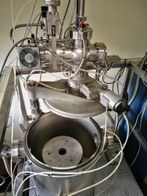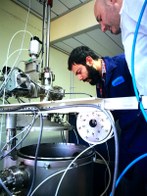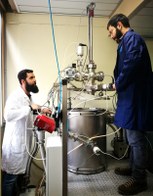Energy: A new “oven” to study alternative solutions for fusion
26/4/2018
 ENEA has recently developed a high-temperature vacuum oven providing the necessary technological skills for manufacturing some components of the DTT (Divertor Tokamak Test facility), the new fusion research machine to be built in Lazio region, Italy. It's a metal cylinder the size of a boiler that will be used to study the properties of the CPS (Capillary-Pore System), sponges soaked with liquid metal to be used in the divertor as material directly facing plasma. The surface of the liquid metal is not inherently subject to damage inside the tokamak and this represents a solution to the problem of deterioration of solid materials, lenghtening the life cycle of such a key component of the future reactor as the divertor.
ENEA has recently developed a high-temperature vacuum oven providing the necessary technological skills for manufacturing some components of the DTT (Divertor Tokamak Test facility), the new fusion research machine to be built in Lazio region, Italy. It's a metal cylinder the size of a boiler that will be used to study the properties of the CPS (Capillary-Pore System), sponges soaked with liquid metal to be used in the divertor as material directly facing plasma. The surface of the liquid metal is not inherently subject to damage inside the tokamak and this represents a solution to the problem of deterioration of solid materials, lenghtening the life cycle of such a key component of the future reactor as the divertor.
 In the ENEA Frascati Research Center, these special tungsten sponges will be soaked in a liquid tin pool inside the oven, at a temperature of 1200 degrees Celsius, making it possible to study the absorption of the tin by the sponge and investigate the corrosion phenomena entailed by the use of this metal.
In the ENEA Frascati Research Center, these special tungsten sponges will be soaked in a liquid tin pool inside the oven, at a temperature of 1200 degrees Celsius, making it possible to study the absorption of the tin by the sponge and investigate the corrosion phenomena entailed by the use of this metal.
As of today, the only tokamak testing the use of tin as liquid metal is the FTU (Frascati Tokamak Upgrade) at the ENEA Frascati Research Center. In this case the sponges were developed jointly with a research center in Russia.
“While continuing the collaboration, the new oven in Frascati will enable us to acquire the know-how necessary to manufacture the CPS and develop innovative solutions, in order to set up a project to be installed on the future DTT machine”, Giuseppe Mizzitelli, Head of the Nuclear Fusion Technologies Department, commented.
 This study, funded by EUROfusion, has involved technical staff, including Luigi Verdini, Mario Mezzacappa, Valerio Cerri, Stefano Rueca and Marco Vellucci, who were concerned with the installation of the oven, jointly with the 24-year-old Mario Iafrati, PhD student at the Padua University, who has been conducting his research project in Frascati for four years. As Giuseppe Mazzitelli pointed out: “the involvement of young people in our research centers is proof of the importance ENEA gives to training, a fundamental prerogative especially in a research field with such a promising future as fusion. So much so now that we’re engaged in the DTT challenge, with the involvement of over 150 young researchers and up to 1500 people involved in building the DTT.
This study, funded by EUROfusion, has involved technical staff, including Luigi Verdini, Mario Mezzacappa, Valerio Cerri, Stefano Rueca and Marco Vellucci, who were concerned with the installation of the oven, jointly with the 24-year-old Mario Iafrati, PhD student at the Padua University, who has been conducting his research project in Frascati for four years. As Giuseppe Mazzitelli pointed out: “the involvement of young people in our research centers is proof of the importance ENEA gives to training, a fundamental prerogative especially in a research field with such a promising future as fusion. So much so now that we’re engaged in the DTT challenge, with the involvement of over 150 young researchers and up to 1500 people involved in building the DTT.
